If you work for an innovative company with an FDA-approved healthcare AI solution, it can be a shock when you realize that no one is lining up to buy your well-designed and full-of-value product. But there are no shortcuts, and you have to stand in line with everyone else unless you’ve generated evidence that your product can improve the customers’ business model. This can be in the form of a well-designed trial or carefully collecting the evidence of the benefits of your solution while doing pilots with initial customers.
When it’s time to make the sale, you need to decide how to price it. Will you go with a subscription model, a SaaS model or a pilot model? How about a percentage of the value created as part of a value-based contract that the provider is participating in?
The answer will vary depending on the type of solution you’re selling, but a good rule of thumb is to stay out of any model that pays you based on the adoption of the solution or the demonstrable value provided. Both of those are poison for a young company. It always takes longer than you expect for users to adopt your solution, and showing the value you’ve added in a value-based contract is difficult to quantify and takes time. This can mean that you’ll go out of business before you see any of the money.
You should aim for contracts that pay you at least a minimum annual fee, regardless of usage or value shown. This minimum fee should cover your costs of servicing the contract and include some margin. This will at least keep the lights on for your business until the widespread adoption of AI solutions becomes commonplace. In order to maximize revenues, a transaction or user-based revenue model will ensure that you capture as much value as possible from the solution you’re providing. Generally, AI-based platforms are in the cloud and there are variable costs associated with the amount of cloud space you use that are proportional to the amount of data that’s processed through the system. As such, figure out the drivers of the variable costs and ensure that your pricing model reflects that.
I’ve never been a fan of the cost-plus pricing model. When I was a McKinsey consultant, I saw how companies left significant amounts of money on the table because they opted for some arbitrary margin above their costs, when the customer would have paid much more since they got significant value from the solution. As such, figuring out the economic value to the customer and trying to capture a portion of that value in your pricing may result in you realizing that you have more pricing power. However, making sure you know what it costs to provide the solution and ensuring that your pricing is at least in line with your competitors is a simple way to make sure you’re not significantly under-pricing your offering.
Another key issue is that healthcare customers are slow to pay. The cash cycle is even longer than the sales cycles, and the sales cycles are really long! What I refer to as the cash cycle includes sales cycle, contracting time, implementation time and collection of the first invoice. This can be quite long and perilous to your business. At Acupera, we often had to wait 4-5 months to get paid when our contracts had payables of 30-60 days. This means calling repeatedly to collect, and since you’re not sitting on top of a big cash cushion, you may have to go to your investors to bridge you until you get paid. It’s not a good situation to be in, and they’ll eventually run out of patience and cut you off. As such, be sure to estimate all of this and to carefully manage your cash. Raise more money to anticipate and be covered for these long cash cycles or keep your burn rate lower since it’ll be a while before you get paid, even after you make the sale.






